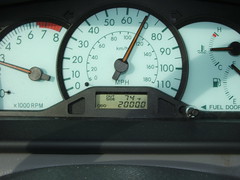Hello again. Mike here. Today I am going to discuss some issues regarding automobiles. Don’t worry—I won’t get too crazy with the details as one could write an entire novel on this subject. It will be rather minor things that can have a big impact on your tax return. Also keep in mind that this is geared towards self employed taxpayers who use their auto for business and report income and expenses on Schedule C and not necessarily employees who use their vehicle for business and report it on a Form 2106.
Let’s get started with some numbers. The 2012 Standard mileage rate is 55.5 cents per mile. It is expected to be 56.5 cents per mile in 2013. A taxpayer can either deduct actual costs incurred by the taxpayer’s automobile, or use the standard mileage rate method to calculate the amount deductible by business use.
Most people use the standard mileage rate for whatever reason – it produces more of a tax benefit or he or she has not been keeping track of actual expenses. What makes up this seemingly arbitrary 55.5 cents(2012) or 56.5 cents (2013) per mile anyway? The IRS says that depreciation, lease payments, maintenance and repairs, gasoline, oil, insurance, and vehicle registration fees all make up this cents per mile figure.
Where most people jump off the diving board too early is figuring the costs NOT included in the standard mileage rate. These are costs IN ADDITION to deducting the standard mileage rate and it is applied using the business percentage of the vehicle. Parking fees and tolls are applied 100%.
These costs include:
Interest Expense
Personal Property Taxes
Parking Fees
Parking Tolls
Let’s do a quick example to demonstrate your tax savings. A single, self employed individual (we’ll call her Mary) makes $50,000 doing a catering business. Her cost of goods sold is $25,000 making gross income $25,000. She records 20,000 business miles out of 25,000 miles for the year. The overall balance due for this taxpayer is $2,061. Keep it simple here; don’t worry about dependents, adjustments to income, credits, etc.
She just records her mileage and nothing else because that is what she has been doing for years.
However, after talking to her astute accountant, she later points out that she paid $100 parking fees, a few tolls at $50, $300 in interest on the car, and paid considerate personal property taxes of $308.
The parking fees and tolls get added dollar for dollar to the standard mileage rate calculation. The interest and the personal property taxes are added by the business percentage or 80% (20,000 business miles/25,000 total miles). This “extra” $636 ($100 parking fees + $50 tolls + (80% * $300 interest) + (80% * 308 personal property tax)) is added IN ADDITION to the business mileage calculation.
After adding to additional information to the automobile, her balance due becomes $1,922.
Her tax savings are $139 ($2,061 – $1,922).
Happy Savings!
-Michael
P.S. Attached is a 2012 auto expense worksheet that will help you organize your automobile expenses and help you decide whether to do the standard mileage rate or actual expenses method.
2012 Auto Expense Worksheet




